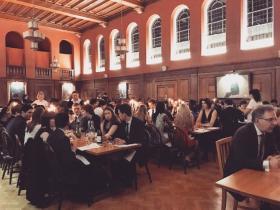We all know what food we like but is this determined just by our taste buds? At last Friday’s formal hall, diners were the willing guinea pigs to an experiment exploring this question, organised by our MSc student Jessica Rowley. She tells us more about her research project below
I have always been a huge fan of food and hoped to pursue a food-related career. I am particularly interested in the ‘weird and wonderful’ side of food, such as the innovative and experimental food preparation styles of celebrity chefs like Heston Blumenthal. Fortunately, I can combine my love of food and research in the MSc in Psychological Research that I am currently undertaking at LMH. I work with Professor Charles Spence in the Crossmodal Laboratory (Experimental Psychology Department) where we study the integration of information across the various sensory modalities (hearing, vision, touch, taste, and smell). My project aims to bring together research areas from psychology, nutrition, health, consumer research, and culinary science to look at the effects of manipulating the senses to control the amount we eat and how we enjoy food.
A large body of research has already demonstrated that manipulating specific elements of food’s visual preparation, such as colour and shape, can influence our feelings towards it. For example, adding red food colouring to white wine can fool even the experts to perceive the aroma of red wine (Morrot, Brochet & Dubourdieu, 2001), while a mousse dessert served on a white plate is perceived as 10% sweeter than the same dessert served on a black plate (Piqueras-Fiszman, Alcaide, Roura & Spence, 2012). The exact way the food is presented is also important. It has been shown that food centred on a plate and presented in a neat, artistic fashion is more liked, considered more artistic, and diners will pay substantially more for it, compared to more asymmetrical or messy plating (Michel, Velasco, Fraemohs, & Spence, 2015; Velasco, Michel, Woods, & Spence, 2016). It also affects how much people consume. For example, food presented flat on a plate is perceived as being a bigger portion size compared to when the same food is stacked vertically, yet people eat less compared to its stacked counterpart (Szocs & Lefebvre, 2017). This type of research is important not only for the fine dining industry but also more widely for us as a society. Finding the optimal plating style that increases enjoyment but decreases the amount consumed has both health benefits and could potentially reduce food waste.
LMH is my college and I love our dining hall, so formal hall is a great opportunity to conduct some of my research and share it with others. I worked with Wendy the Catering Manager and Markus, the Head Chef, to design the plated food and the event– I couldn’t have done this without them! My objective was to replicate some of the previously identified concepts of portion size control but also explore how the mood and personality of individual people affected their enjoyment of food. Diners were presented with four different plates, one with the food stacked vertically and centred, one with stacked and off-centre, one with the food flat to the plate and centred and the final dish flat but off-centre. I also looked at food type by manipulating the presentation of both starters and desserts. The event was a gret success and generated many interesting discussions over the dinner table. I am looking forward to analysing the results of this experiment and seeing what I find. Thank you to everyone who participated!
In the future I hope to explore how other senses affect our perception of food. The latest evidence from the field of sonic seasoning, the idea that music can enhance the flavour of our food, suggests that one can use especially composed music and soundscapes to accentuate certain components of the tasting experience. For example, sounds with characteristics such as high notes or staccato-like rhythms have been shown to enhance the sweetness of several foods and the sweet notes in wine (Spence & Wang, 2015). I hope to host a “Musical Cheeseboard”, an experimental cheese and wine tasting experience, on Saturday the 28th here at LMH with LMH Cheese Society, which should give me some insight on this.
I hope to undertake a DPhil program here at Oxford so that I can continue the work I am doing in plating and hopefully keep running different experimental dining events for people to enjoy!

Find out more
Follow Jessica on twitter and on instagram
Find out more about this research on the Crossmodal Laboratory website
Watch Jessica discuss her project on this instagram video:
References
Michel, C., Velasco, C., Fraemohs, P., & Spence, C. (2015). Studying the impact of plating on ratings of the food served in a naturalistic dining context. Appetite, 90, 45-50.
Morrot, G., Brochet, F., and Dubourdieu, D. (2001). The color of odors. Brain Lang. 79, 309–320.
Piqueras-Fiszman, B., Alcaide, J., Roura, E., & Spence, C. (2012). Is it the plate or is it the food?
Assessing the influence of the color (black or white) and shape of the plate on the perception of the food placed on it. Food Quality and Preference, 24(1), 205-208.
Spence, C., & Wang, Q. J. (2015). Wine and music (II): can you taste the music? Modulating the experience of wine through music and sound. Flavour, 4(1), 1.
Szocs, C., & Lefebvre, S. (2017). Spread or stacked? Vertical versus horizontal food presentation, portion size perceptions, and consumption. Journal of Business Research.
Velasco, C., Michel, C., Woods, A. T., & Spence, C. (2016). On the importance of balance to aesthetic plating. International Journal of Gastronomy and Food Science, 5, 10-16.